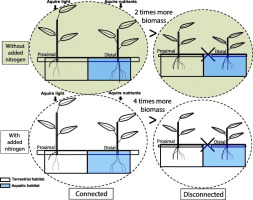Science of the Total Environment ( IF 8.2 ) Pub Date : 2017-11-10 , DOI: 10.1016/j.scitotenv.2017.11.025 Hui-Feng Lin , Peter Alpert , Qian Zhang , Fei-Hai Yu

|
Physiological integration of connected ramets of clonal plants can increase clonal performance when ramets grow in contrasting microenvironments within a habitat. In amphibious clonal species, integration of ramets in different habitats, terrestrial and aquatic, is possible. This may increase performance of amphibious clones, especially under eutrophic conditions. To test this, clonal fragments consisting of two ramets of the amphibious, perennial, climbing herb Ipomoea aquatica connected by a stem were placed such that the proximal ramet was rooted in a simulated riparian community of four other species, while the distal ramet extended into a simulated aquatic habitat with open water and sediment. The connection between ramets was either left intact or severed, and 0, 5, or 25 mg N L− 1 was added to the aquatic habitat to simulate different degrees of eutrophication. Without added N, fragments in which the original ramets were left connected accumulated two times more total mass than fragments in which the ramets were disconnected from one another. The positive effect of connection increased two-fold with increasing N. These results were consistent with the hypotheses that physiological integration between connected terrestrial and aquatic ramets can increase clonal performance in plants and that this effect can be greater when the aquatic ramet is richer in nutrients. Connection reduced root to shoot ratio in terrestrial ramets, but increased it in aquatic ones, suggesting that physiological integration induced a division of labor in which terrestrial ramets specialized for light acquisition and aquatic ramets specialized for acquisition of nutrients. This provides the first report of increase in clonal performance and induction of division of labor due to physiological integration between ramets in different habitats.
中文翻译:

通过生理整合促进无性,多年生攀缘草本水生番薯两栖习性
当分株在栖息地内相反的微环境中生长时,克隆植物的分株的生理整合可以提高克隆的性能。在两栖克隆物种中,分株可能在陆地和水生不同生境中融合。这可以提高两栖克隆的性能,尤其是在富营养条件下。为了测试这一点,放置了由两个两栖,多年生攀缘草本植物番薯I的两个分株组成的克隆片段,该分枝通过茎连接,从而使近端分株扎根于其他四个物种的模拟河岸群落中,而远端分株则延伸成一个分枝。具有开放水域和沉积物的模拟水生生境。分株之间的联系保持完整或被切断,0、5或25 mg NL -1被添加到水生栖息地以模拟不同程度的富营养化。如果不添加N,原始分枝保持连接的片段的总质量是分枝彼此断开的片段的总质量的两倍。连接的积极作用随氮含量的增加而增加了两倍。这些结果与以下假设相吻合:陆生和水生分株之间的生理整合可以提高植物的无性系表现,并且当水生分株富含营养素时,这种影响可能会更大。 。连接减少了陆地分株的根冠比,但增加了水生分株的根冠比,这表明生理整合引起了分工,其中陆地分株专门用于光的采集,而水生分株专门用于营养的采集。这提供了第一个报道,由于不同生境中分株之间的生理整合,克隆性能提高和分工诱导。











































 京公网安备 11010802027423号
京公网安备 11010802027423号